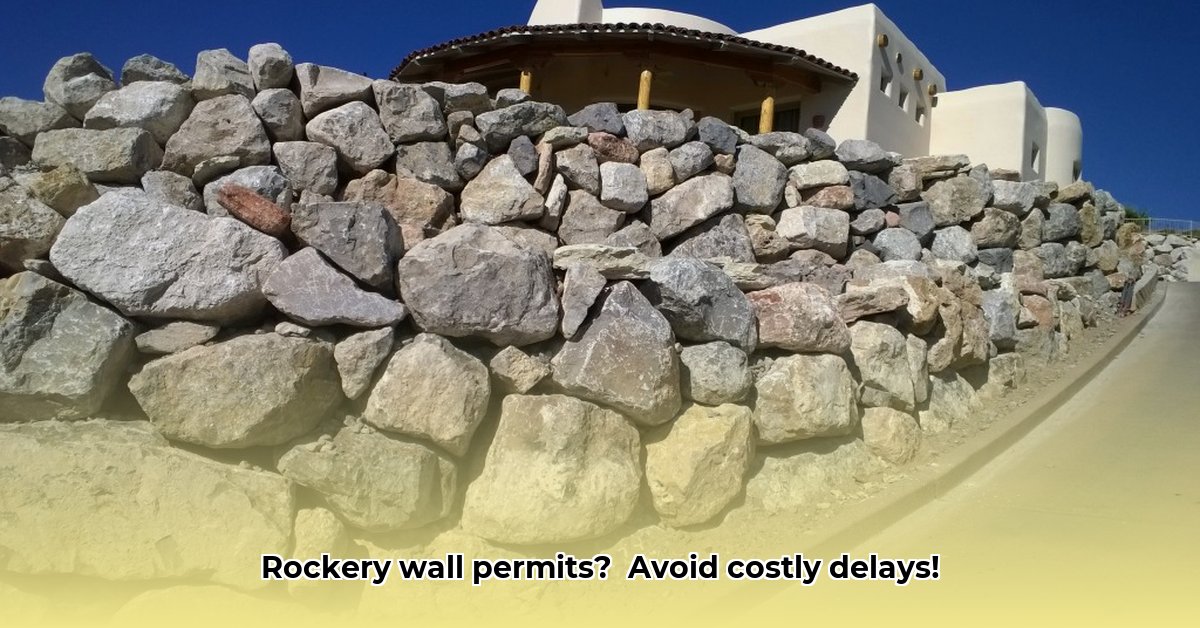Thinking about building a beautiful rock wall or rockery on your property? It might seem straightforward, but there are rules and regulations you need to know about before you even pick up a shovel. For inspiration on permeable paving, check out this article on paver options. This guide will help you navigate the world of permits and approvals, whether you’re a seasoned DIYer or just starting out. We’ll cover differentiating between a simple rockery and a more complex retaining wall and knowing when you need to hire a professional. We’ll even show you how to make sure your project will last for years. Let’s get started and build your dream rock feature – the easy way!
Rockery Wall Permits: Avoid Delays, Build Smart
Building a rockery wall enhances your landscape, but before hauling rocks, let’s talk permits. Navigating the rules can feel like a maze, but with planning, you can avoid headaches and ensure your project goes smoothly.
Understanding Height Restrictions and Wall Stability
Local governments regulate the height of rockery walls. A small wall, maybe a couple of feet high, might require less paperwork. However, a taller wall—say, four feet or more—gets more complicated and requires assessing wall stability. Professional blueprints and a more involved permit process will likely be needed. Check local building codes – that’s your first step before digging that first hole. Building codes dictate maximum height without a permit, setback requirements from property lines, and required safety features.
The Permitting Process: A Step-by-Step Guide to Success
Getting permits may seem daunting, but breaking it down makes the process easier.
- Know the Rules of the Land (Literally). Contact your local building department. They’re your best resource for understanding regulations in your area. Don’t rely on online information alone; local rules vary.
- Size Up Your Project. Grab your measuring tape and determine the height and length of your planned rockery wall. Will your project involve moving a lot of earth? The more extensive your project, the more intricate the permit process will likely be.
- Environmental Impact Assessment – Protecting Nature and Your Project. Are you building near environmentally sensitive areas (wetlands, streams, etc.)? This adds complexity to the permitting process. Protect the environment and safeguard your project from potential roadblocks.
- When to Call in the Pros. For larger rockery walls or those near environmentally sensitive areas, a geotechnical engineer is a wise investment. They can ensure your design is structurally sound and meets all regulations. Don’t risk a collapse—get the expert opinion, especially for involved projects. Landscape architects and qualified contractors provide expertise in design, construction techniques, and local code compliance.
- Submit Your Application – Get it Right the First Time. Fill out the permit application completely and accurately. Include all necessary plans and documentation. A flawed application can delay the whole process, so double (and triple) check everything. Include site plans, elevation drawings, materials specifications, and engineering calculations, where applicable.
- The Waiting Game (and Follow-Up). Permit processing times vary. Be patient, but don’t be afraid to follow up if the timeline seems unusually long. Document all communication with the permitting office and maintain a record of submission dates and expected review times.
- Construction and Inspections – Stay Organized. After approval, you can begin construction. Remember to schedule inspections as required—this varies by location and project scale. Keeping meticulous records during construction helps streamline this step. Inspections typically occur at various stages, such as after excavation, during construction of the wall, and upon completion.
Risk Management: Protecting Your Investment and Avoiding Cost Overruns
Building a rockery wall involves potential risks. Steps to protect your investment and avoid cost overruns:
| Risk Factor | Likelihood | Impact | Mitigation |
|---|---|---|---|
| Permitting Delays | Moderate | Moderate | Thorough pre-application consultation with local building authorities. |
| Environmental Damage | Low | High | Professional assessment; strict adherence to all environmental regulations. |
| Property Line Encroachments | Moderate | High | Professional survey; clear communication with neighbors. |
| Structural Failure | Low | High | Experienced contractor; robust design and proper drainage. |
| Cost Overruns | Moderate | Moderate | Comprehensive budgeting; contingency fund; firm contracts with contractors. |
Planning Your Rockery Wall: Key Considerations
Remember, safety and compliance go hand in hand. Don’t rush the process, and always prioritize safety. While a DIY approach might seem appealing for smaller projects, professional guidance is invaluable for larger or more complex builds. The beauty of your finished rockery wall shouldn’t come at the cost of legal compliance or structural integrity. Plan carefully, build wisely and enjoy your beautiful rockery wall!
Consider these key factors during the planning phase:
- Soil Type: Understand the soil composition on your property. Sandy or unstable soils may require additional reinforcement measures.
- Drainage: Proper drainage is critical to prevent hydrostatic pressure from building up behind the wall. Incorporate drainage systems like perforated pipes and gravel backfill.
- Material Selection: Choose materials that are durable, weather-resistant, and suitable for your local climate.
- Aesthetics: Consider the overall look and feel of your landscape. Select rocks that complement your existing landscaping and architecture.
How to Navigate Varying Retaining Wall Permit Requirements by State
Building a rockery wall is functional and beautiful, but it also requires careful planning. Before you break ground, a crucial first step: understanding the permitting process, which is not a one-size-fits-all affair.
Instead, how to navigate varying retaining wall permit requirements by state is a journey. As you consider the project, remember these key points:
- Retaining wall regulations vary significantly by state, county, and even city. Contact your local building department and zoning office to obtain the most accurate information for your specific location.
- Wall height is a major factor influencing permit needs—taller walls usually require more extensive permits and professional engineering. Walls exceeding 4 feet in height generally trigger stricter regulations, often necessitating engineered drawings and inspections.
- Understanding your local codes is crucial before starting any project. Familiarize yourself with local zoning ordinances, building codes, and environmental regulations.
- Failing to obtain necessary permits can lead to costly fines and project delays. Non-compliance can result in stop-work orders, fines, and even legal action.
- Professional help can simplify navigating complex regulations. Consult with a qualified engineer, landscape architect, or contractor experienced in retaining wall construction.
Understanding the Regulatory Landscape and Landscaping Design
The United States doesn’t have a national standard for retaining wall construction. Each state, county, and city often have its own rules. This creates a complex web of regulations, meaning what’s acceptable in one location might be prohibited in another. This variation complicates matters for both homeowners and contractors and often requires understanding landscaping design. Regulations cover aspects like wall height, setback distances, material types, and drainage requirements.
Height Restrictions: A Key Determinant
One of the most significant factors affecting permit requirements is the height of your intended wall. Generally, walls exceeding four feet trigger stricter regulations. This threshold varies across localities, though. Some jurisdictions may set the limit at three feet or higher than four feet. Homeowners should be aware of specific height restrictions in their area and plan their projects accordingly. Check for local ordinances.
Permitting Process: Your Step-by-Step Guide
- Research Local Regulations: Begin by contacting your local building department or planning office. They possess the most up-to-date information on your area’s specific codes. Inquire about zoning regulations, building codes, and any other applicable requirements.
- Determine Permit Requirements: Based on your wall’s design (height, materials, proximity to property lines, environmental considerations), determine the type of permits needed. Depending on the scope of the project, you may need building permits, grading permits, or environmental permits.
- Engage Professionals (If Needed): For larger or complex projects, a structural engineer’s input is vital. An engineer’s review ensures the wall meets safety standards and simplifies acquiring permits. An engineer can assess soil conditions, calculate load-bearing capacity, and design a wall that meets all applicable codes and regulations.
- Prepare and Submit Your Application: Follow instructions carefully. Incomplete applications cause delays. Your application should include complete drawings, specifications, and any required supporting documentation. Include detailed site plans, elevation drawings, materials specifications, and engineering calculations, where applicable.
- Obtain Necessary Approvals: Expect a review period and be prepared to address any concerns raised by the permitting authority. Be prepared to provide additional information or make revisions to your design as requested.
- Begin Construction: Once permits are approved, proceed with the construction, ensuring compliance with the conditions stated in your permit. Schedule inspections at various stages of construction to ensure compliance with approved plans and regulations.
Material Considerations and Erosion Control
Beyond height, the materials you choose affect the permitting process. Some jurisdictions favor specific materials for retaining walls for stability and environmental reasons. Certain materials might be restricted altogether. This is often related to the overall stability and environmental impact of the project and is important for erosion control. Local regulations may require the use of specific erosion control measures, such as silt fences or erosion blankets.
Environmental Concerns and Waterways Protection
Many areas have environmental protection laws that influence retaining wall construction. These regulations often require considerations for erosion control, impact on vegetation, and protection of waterways
- Gray Kitchen Backsplash Tile: Ideas for a Stylish Upgrade - December 14, 2025
- Backsplash For Gray Cabinets: Choosing the Right Backsplash Style - December 13, 2025
- Gray And White Backsplash: Ideas For Timeless Style - December 12, 2025









